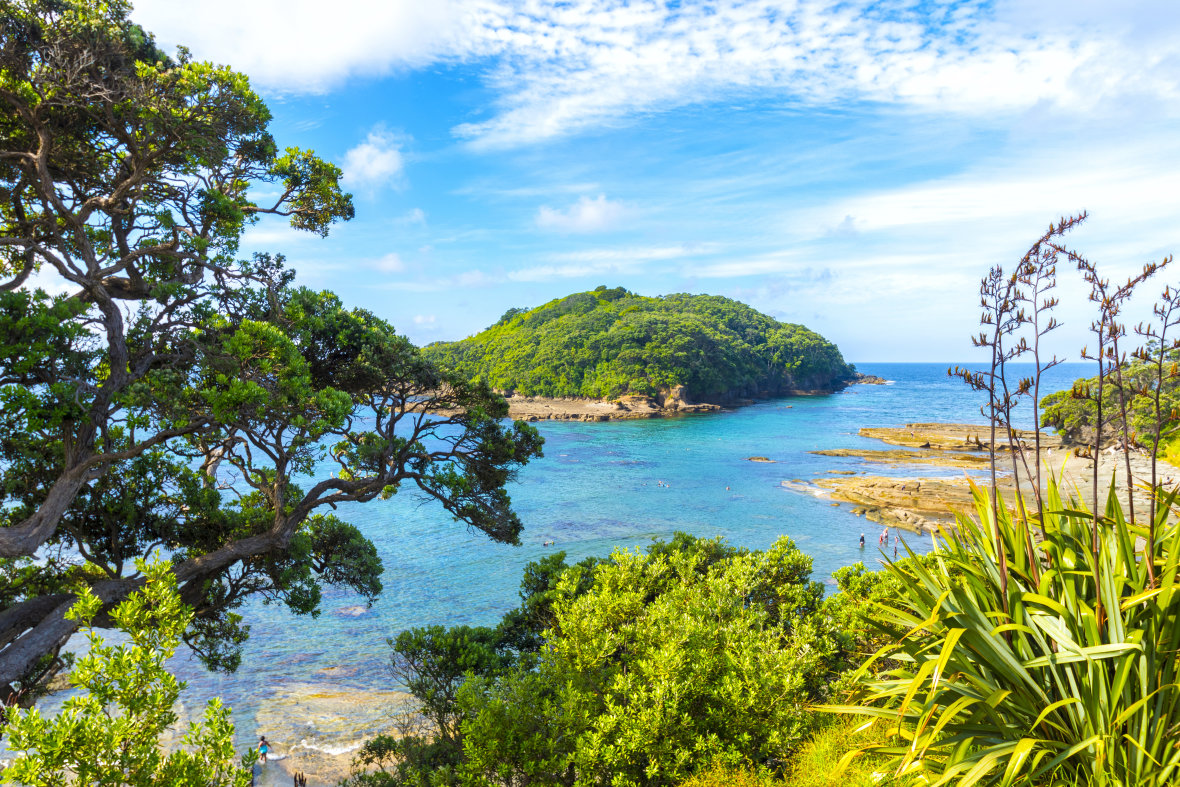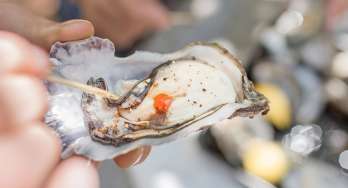Why do people go to Goat Island Marine Reserve?
Located just outside the coastal town of Leigh, Te Hāwere-a-Maki / Goat Island Marine Reserve offers visitors a unique chance to experience one of New Zealand’s most celebrated marine environments. As New Zealand’s first marine reserve, it protects an underwater world rich in biodiversity and makes marine life easy to see – even from the shore.
Goat Island snorkelling is especially popular, with calm, shallow waters and regular sightings of snapper, blue maomao, eagle rays, and even crayfish. Whether you're swimming near the rocky reefs or floating over the sandy seabed, it’s an accessible way to see native species up close. Those who prefer to stay dry can join glass-bottom boat tours of Goat Island, which departs regularly from the beach and offers excellent views of the marine life below.
Alongside its natural appeal, Goat Island is also a key site for marine conservation and research. The nearby Leigh Marine Laboratory, operated by the University of Auckland, supports ecological studies and education programmes that are globally recognised. As a result, the reserve has become a case study in successful protection and biodiversity restoration.
Visitors can also enjoy walking tracks, rockpooling, or simply relaxing by the water. The site offers a well-rounded experience for those interested in marine life, nature-based learning, or just a scenic day out.
How long should I spend at Goat Island Marine Reserve?
Most travellers spend half a day to a full day at the reserve. If you're keen to snorkel, swim, or join a glass-bottom boat tour, allow at least 3–4 hours to enjoy these activities without feeling rushed.
There’s also time to explore the nearby Goat Island Marine Discovery Centre, relax with a packed lunch, or walk some of the short tracks in the area. If you’re visiting with kids or planning a relaxed day in nature, a full day allows you to move at an easy pace and take breaks between activities.
Goat Island is also close to attractions in Leigh and Matakana, so you could combine it with stops at local cafés, galleries, or vineyards.
Why is Goat Island a marine reserve?
The Cape Rodney–Okakari Point Marine Reserve, commonly known as Goat Island Marine Reserve, was established in 1975. It was the first area in New Zealand where marine life received full legal protection from fishing, harvesting, or disturbance.
The goal was to protect this coastal ecosystem, which had been under pressure from fishing and development, and allow species and habitats to recover. Since then, fish numbers and biodiversity have significantly increased, making the area a rare example of a thriving, restored marine environment.
Today, Goat Island serves as a valuable marine conservation case study. It's also an important research site and teaching tool, helping New Zealanders better understand the importance of ocean protection.

How to get to Goat Island Marine Reserve
From Auckland: The reserve is around 90 km north of Auckland, and the drive typically takes 1.5 hours, depending on traffic. Take State Highway 1 north toward Warkworth, then follow signs through Matakana to Leigh. Once in Leigh, head north on Leigh–Pakiri Road and then turn right onto Goat Island Road. The car park is at the end of this road.
From Matakana: If you're based nearby, it’s just a 10-minute drive to Goat Island. Follow the brown road signs leading toward the coast.
Best time to visit Goat Island Marine Reserve
Best time of year: The summer months (December to February) offer the warmest water and the best visibility for snorkelling and diving. Marine life is also more active, making sightings more frequent.
Spring (September to November) and autumn (March to May) are good alternatives, especially for those looking to avoid the busier summer crowds. Temperatures remain mild, and visibility is often still excellent in the mornings.
Best time of day: Plan your visit for high tide, as water clarity is typically best a couple of hours after the moon is at its highest point in the sky. Early mornings usually offer the calmest sea conditions and fewer visitors, making it easier to spot fish and enjoy a more peaceful atmosphere.
Weather at Goat Island Marine Reserve
Goat Island has a temperate coastal climate:
-
Summer (Dec–Feb): 22–26 °C
-
Autumn/Spring: 16–22 °C
-
Winter (Jun–Aug): 10–15 °C
Rainfall is spread fairly evenly throughout the year, though summer tends to have more dry days. Conditions can change quickly near the coast, so it’s a good idea to check the marine forecast before heading out, especially if you plan to swim or snorkel.
Best place to park your campervan at Goat Island Marine Reserve
The best parking option is the DOC car park at 123 Goat Island Road, Leigh. It’s large enough to accommodate campervans and includes toilets and basic facilities. During summer and public holidays, it can fill up quickly, so plan to arrive early if possible.
From the car park, it’s about 250 metres down a gentle hill to the main beach and marine reserve facilities.
There’s no freedom camping permitted here, so you’ll need to move on after your visit if you're staying in a campervan overnight. The nearest options are in and around Leigh and Matakana.
Road trips that pass through



